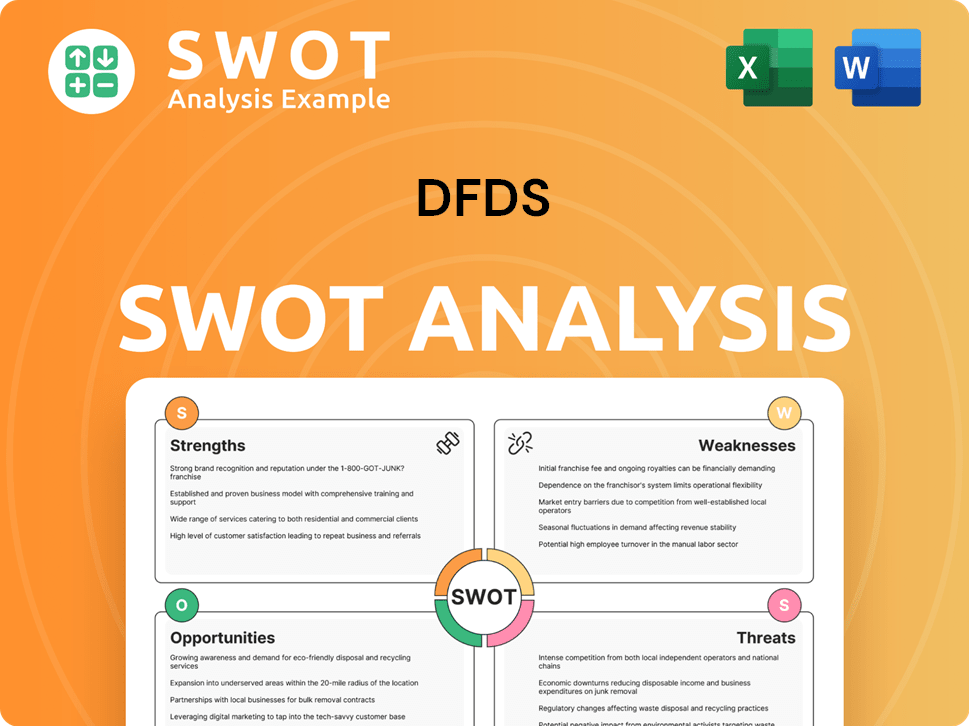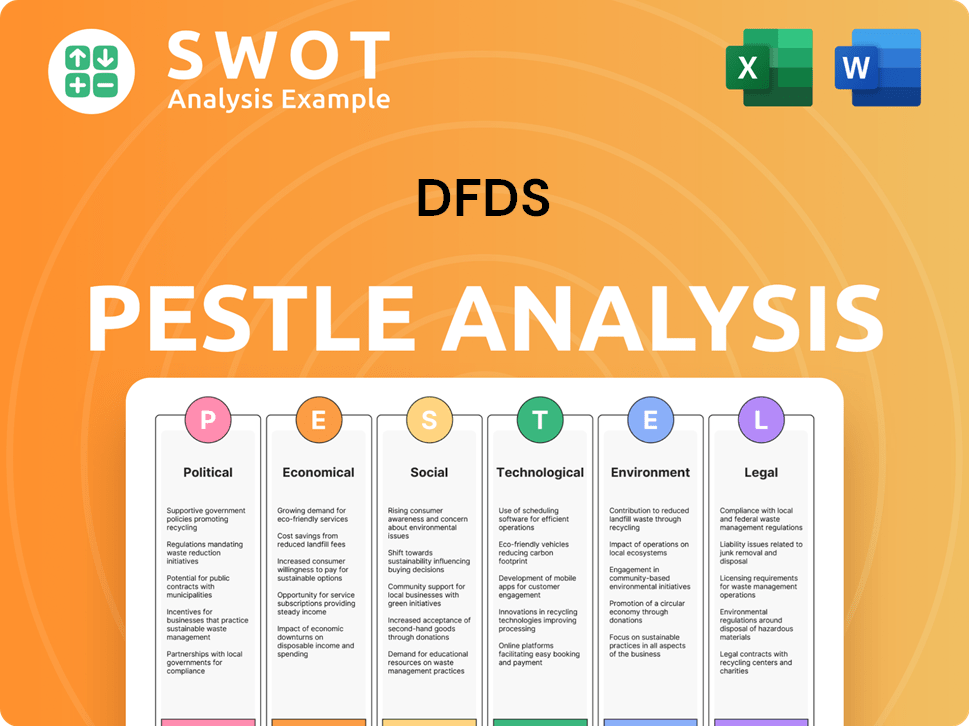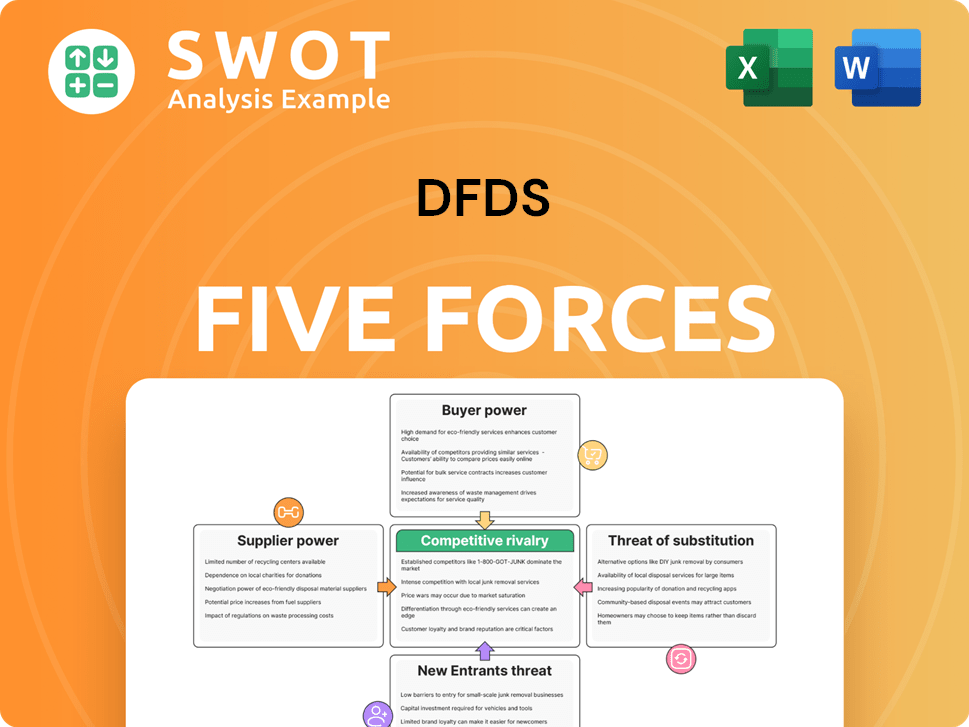DFDS Bundle
How Does DFDS Navigate the Complex European Transport Market?
DFDS, a global leader in shipping and logistics, has consistently refined its DFDS SWOT Analysis to stay ahead. Launched in December 2023, the 'Moving Together Towards 2030' strategy highlights DFDS's commitment to both growth and environmental sustainability. This strategic shift reflects a proactive approach to the evolving demands of the European transport sector.

This analysis delves into the core of DFDS's DFDS sales strategy and DFDS marketing strategy, exploring how it leverages its extensive network of passenger and freight ferry routes and comprehensive logistics solutions. We'll examine the DFDS business model, dissecting its DFDS shipping and DFDS logistics operations, and evaluating how the company maintains its competitive edge through innovative DFDS strategy and customer-centric approaches. Understanding the intricacies of DFDS's approach offers valuable insights for anyone interested in the dynamics of the transport and logistics industry.
How Does DFDS Reach Its Customers?
The sales channels of DFDS are multifaceted, designed to reach a broad customer base across its passenger and freight services. The company employs a blend of online and offline strategies, with a strong emphasis on digital platforms. This approach is crucial for enhancing customer service and operational efficiency.
DFDS's sales strategy leverages its website and e-commerce platforms for bookings, alongside direct sales teams for logistics and freight services. Its extensive network of ferry routes serves as a physical sales point, with routes spanning Northern Europe, the Baltic Sea, and the Mediterranean. The company continuously adapts its channels to meet market demands and strategic objectives.
The company's strategic moves, such as acquisitions and concession contracts, highlight its adaptability. For instance, the acquisition of FRS Iberia/Maroc in 2024 expanded its reach, and securing a 20-year concession for Jersey ferry services starting in March 2025 further solidified its market presence. These actions are part of an omnichannel integration strategy aimed at providing seamless customer experiences.
DFDS utilizes its website and e-commerce platforms as primary digital sales channels. These platforms facilitate bookings for both passenger journeys and freight services. Continuous efforts are made to standardize and digitize its network to improve customer service and operational efficiency, which is a key aspect of its Revenue Streams & Business Model of DFDS.
Direct sales teams are a crucial component, especially for logistics and freight services. These teams engage directly with businesses to offer tailored solutions. The direct approach allows for building strong relationships and understanding specific customer needs, which is vital for securing contracts and ensuring customer satisfaction.
DFDS's extensive ferry route network serves as a significant physical sales channel. With routes across Northern Europe, the Baltic Sea, and the Mediterranean, these ferries provide direct interaction with customers. This network includes both freight and combined freight and passenger routes, enhancing accessibility and sales opportunities.
Strategic moves, such as the 2024 acquisition of FRS Iberia/Maroc and securing the Jersey ferry services concession beginning in March 2025, are pivotal. These actions expand the company's market reach and enhance its integrated ferry-logistics offerings. These expansions are key to DFDS's growth strategy and market positioning.
DFDS continuously optimizes its sales channels to align with market demands and strategic objectives. This includes a focus on omnichannel integration to provide seamless customer experiences. The company's approach ensures that customers can interact with DFDS through various channels, enhancing convenience and satisfaction.
- Digital platforms for bookings and information.
- Direct sales teams for personalized service.
- Physical ferry routes for direct customer interaction.
- Strategic acquisitions to expand market reach.
DFDS SWOT Analysis
- Complete SWOT Breakdown
- Fully Customizable
- Editable in Excel & Word
- Professional Formatting
- Investor-Ready Format

What Marketing Tactics Does DFDS Use?
The marketing tactics employed by DFDS are multifaceted, encompassing both digital and traditional methods to boost brand awareness, generate leads, and drive sales. The company's approach is designed to enhance customer experience through innovative digital platforms and strategic partnerships. This comprehensive strategy aims to solidify its position within the shipping and logistics industry.
DFDS integrates digital marketing with traditional approaches to reach a broad audience. They focus on improving customer experience through digital platforms, content marketing, and strategic partnerships. This blend of tactics supports their overall DFDS sales strategy and marketing objectives.
DFDS's marketing strategy is a dynamic blend of digital and traditional approaches, designed to build brand awareness, generate leads, and drive sales. The company's commitment to digital innovation and strategic partnerships highlights its adaptive approach to the market.
DFDS emphasizes digital platforms to enhance customer experience, including improved booking systems and digital customer service solutions. Content marketing, especially video content, is used for lead generation, particularly in the B2B sector. While specific details on SEO, paid advertising, and email marketing campaigns for 2024-2025 are not extensively detailed in public reports, DFDS's commitment to digital innovation suggests their continued use.
Traditional media and events play a significant role, particularly in passenger services. In 2023, over 70 events were planned to engage with customers. Strategic partnerships are also utilized, such as the collaboration with Bennetts British Superbike Championship in April 2024, which included exclusive discounts and trackside branding.
DFDS engages in strategic partnerships to expand its reach and enhance customer engagement. A notable collaboration in 2024 was with Brown-Forman and Gebr. Heinemann for a Jack Daniel's promotion, building on a previous campaign that reached over 1.7 million travelers. These partnerships are a key part of the DFDS marketing strategy.
DFDS adapts its sales strategies based on changing travel patterns and customer segments, as seen on the Oslo-Copenhagen route. The company aims to improve online engagement to expand its potential client base. This data-driven approach supports their overall business model.
DFDS focuses on customer segmentation to tailor its marketing efforts effectively. This involves adapting sales strategies based on changing travel patterns and customer mixes. The company's efforts to digitize its network and enhance customer service also contribute to this.
The 'Moving Together Towards 2030' strategy emphasizes standardizing and digitizing the network to enhance customer service and operational efficiency. This focus on digital transformation supports the overall DFDS strategy and its goals for the future. For more insights, you can explore the Competitors Landscape of DFDS.
DFDS employs a combination of digital and traditional marketing tactics to achieve its sales and marketing objectives. This includes leveraging digital platforms, content marketing, and strategic partnerships. The company focuses on data-driven insights and customer segmentation to optimize its approach. These tactics are crucial for DFDS's success in the competitive shipping and logistics market.
- Digital platform enhancements, including booking systems and customer service.
- Content marketing, especially video, for lead generation.
- Strategic partnerships to expand reach and enhance customer engagement.
- Data-driven marketing to adapt strategies based on customer behavior.
- Emphasis on digitizing the network to improve customer service and efficiency.
DFDS PESTLE Analysis
- Covers All 6 PESTLE Categories
- No Research Needed – Save Hours of Work
- Built by Experts, Trusted by Consultants
- Instant Download, Ready to Use
- 100% Editable, Fully Customizable

How Is DFDS Positioned in the Market?
The brand positioning of the company centers on its role as a reliable, efficient, and comprehensive provider of transport and logistics solutions. This positioning is reinforced by its extensive network of ferry routes and integrated logistics services, which include ferry, road, and rail transport. The core message emphasizes seamless travel experiences and efficient supply chain solutions, which is a key part of the overall DFDS sales strategy.
The company has consistently been recognized as the 'World's Leading Ferry Operator' for 14 consecutive years, including 2024, based on votes from passengers and industry professionals. This highlights a strong appeal to its target audience through a consistent promise of superior service and reliability. The company's brand identity is deeply rooted in its extensive network of ferry routes and integrated logistics solutions, which combine ferry, road, and rail transport. This is further supported by its commitment to sustainability, aiming to become a net-zero company by 2050.
The company differentiates itself through its diversified customer segments (freight and passenger) and geographical reach, enabling complementary service offerings. The focus on a green transition serves as a key unique selling proposition, appealing to environmentally conscious customers and stakeholders. Brand consistency is maintained across various channels, from online booking systems to onboard amenities and customer service, all designed to ensure a smooth and convenient experience. For detailed insights, you can explore the Growth Strategy of DFDS.
The company emphasizes providing seamless travel experiences and efficient supply chain solutions. This includes consistently high service standards across all touchpoints, from booking to onboard services. The goal is to ensure customer satisfaction and build brand loyalty, which is crucial for the DFDS marketing strategy.
A key aspect of the brand positioning is its commitment to sustainability. The company aims to become net-zero by 2050, with significant CO2 emission reduction targets by 2030. This appeals to environmentally conscious customers and stakeholders, enhancing its brand image.
The company differentiates itself through its diversified customer segments (freight and passenger) and geographical reach. Overlapping ferry and logistics networks enable complementary service offerings. This diversified approach helps in mitigating risks and capturing a broader market share.
Brand consistency is maintained across various channels, from online booking systems to onboard amenities and customer service. The company actively responds to shifts in consumer sentiment and competitive threats, adapting its strategies as needed. For example, adjusting to changes in the Mediterranean ferry network due to new competitors in late 2024.
The brand positioning of the company is built on several key elements that contribute to its success in the market. These elements work together to create a strong and consistent brand image.
- Reliability and Efficiency: The company emphasizes dependable and efficient transport and logistics services.
- Comprehensive Solutions: Offering integrated solutions that combine ferry, road, and rail transport.
- Customer-Centric Approach: Focusing on seamless travel experiences and efficient supply chains.
- Sustainability Focus: Commitment to reducing environmental impact and achieving net-zero emissions.
- Geographical Reach: Operating across a wide geographical area with diversified customer segments.
DFDS Business Model Canvas
- Complete 9-Block Business Model Canvas
- Effortlessly Communicate Your Business Strategy
- Investor-Ready BMC Format
- 100% Editable and Customizable
- Clear and Structured Layout

What Are DFDS’s Most Notable Campaigns?
The company's sales and marketing efforts are significantly shaped by its strategic initiatives, with a focus on sustainability and expansion. The 'Moving Together Towards 2030' strategy, launched in December 2023, provides the overarching framework for all customer-facing communications and operational decisions. This strategy emphasizes organic growth and a transition towards greener operations, aiming for net-zero emissions by 2050.
In 2024, the company continued to prioritize customer satisfaction and operational efficiency, which are outcomes of its ongoing digitization efforts. Recent acquisitions, such as FRS Iberia/Maroc and Ekol International Transport, have expanded its network, enhancing its integrated ferry-logistics offerings. These expansions are communicated to both B2B clients and investors, showcasing its growth trajectory and comprehensive service capabilities.
A key aspect of the company's marketing strategy involves collaborations and partnerships to enhance customer experience and drive sales. The company's consistent recognition as the 'World's Leading Ferry Operator' for 14 consecutive years, including 2024, is a testament to its service quality, which is a significant brand-defining achievement widely used in its marketing. This consistent award underscores its commitment to delivering superior service and reliability, which is a significant brand-defining achievement widely used in its marketing.
This overarching strategy, launched in December 2023, guides all sales and marketing activities. It focuses on organic growth and transitioning to a greener company. The goal is to achieve net-zero emissions by 2050, with a 45% reduction in ferry CO2 emission intensity by 2030.
The company expanded its network through acquisitions like FRS Iberia/Maroc and Ekol International Transport in 2024. These strategic moves bolster its presence in high-growth regions. This enhances its integrated ferry-logistics offerings, a key element of its DFDS shipping and DFDS logistics services.
A collaboration with Brown-Forman and Gebr. Heinemann to enhance the travel retail experience. This campaign, running in port shops and on six vessels, aimed to drive sales of premium spirits. It built on a successful 2023 campaign that reached over 1.7 million travelers.
The company has won this award for 14 consecutive years, including 2024. This recognition highlights its commitment to superior service and reliability. This achievement is a significant brand-defining factor, heavily used in its DFDS marketing strategy.
The company employs a multi-faceted approach to sales and marketing, combining strategic initiatives with targeted campaigns. These initiatives support the overall DFDS sales strategy and enhance brand visibility. These efforts are instrumental in driving growth and maintaining a competitive edge in the market.
- Focus on Sustainability: Emphasizing green initiatives and emissions reduction targets.
- Network Expansion: Strategic acquisitions to broaden service offerings and reach.
- Partnerships: Collaborations to enhance customer experience and boost sales.
- Brand Building: Leveraging awards and recognitions to reinforce brand reputation.
- Digital Marketing: Use of digital platforms to reach their DFDS target market strategy.
DFDS Porter's Five Forces Analysis
- Covers All 5 Competitive Forces in Detail
- Structured for Consultants, Students, and Founders
- 100% Editable in Microsoft Word & Excel
- Instant Digital Download – Use Immediately
- Compatible with Mac & PC – Fully Unlocked

Related Blogs
- What are Mission Vision & Core Values of DFDS Company?
- What is Competitive Landscape of DFDS Company?
- What is Growth Strategy and Future Prospects of DFDS Company?
- How Does DFDS Company Work?
- What is Brief History of DFDS Company?
- Who Owns DFDS Company?
- What is Customer Demographics and Target Market of DFDS Company?
Disclaimer
All information, articles, and product details provided on this website are for general informational and educational purposes only. We do not claim any ownership over, nor do we intend to infringe upon, any trademarks, copyrights, logos, brand names, or other intellectual property mentioned or depicted on this site. Such intellectual property remains the property of its respective owners, and any references here are made solely for identification or informational purposes, without implying any affiliation, endorsement, or partnership.
We make no representations or warranties, express or implied, regarding the accuracy, completeness, or suitability of any content or products presented. Nothing on this website should be construed as legal, tax, investment, financial, medical, or other professional advice. In addition, no part of this site—including articles or product references—constitutes a solicitation, recommendation, endorsement, advertisement, or offer to buy or sell any securities, franchises, or other financial instruments, particularly in jurisdictions where such activity would be unlawful.
All content is of a general nature and may not address the specific circumstances of any individual or entity. It is not a substitute for professional advice or services. Any actions you take based on the information provided here are strictly at your own risk. You accept full responsibility for any decisions or outcomes arising from your use of this website and agree to release us from any liability in connection with your use of, or reliance upon, the content or products found herein.